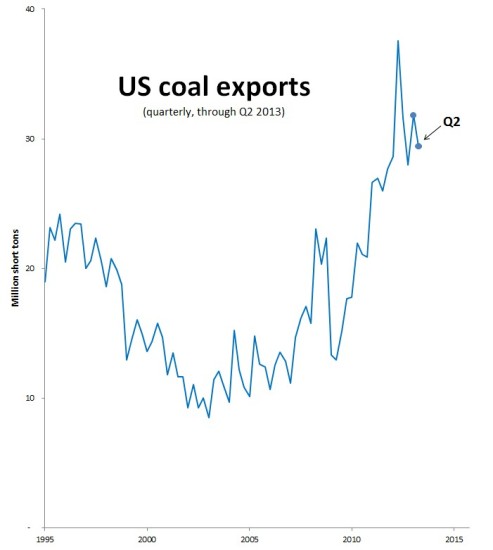The government shutdown did not prevent the EIA from releasing new energy data yesterday. The figures in the latest coal report take us up through the end of June 2013:
Nationally, coal exports tailed off a bit. The US shipped nearly 29.4 million tons of coal in the second quarter of 2013. By historical standards, that’s a lot.
At present, the Western Customs Region plays only a minor role in the national coal exports scene. (It is also, of course, the setting for the ferocious debate over expansion capacity.) In the second quarter, the West Coast exported about 2.3 million tons, a 67 percent jump from the first quarter.
 The biggest player in western coal exports is the Seattle District—entirely accounted for by coal traveling north from Washington into British Columbia for onward shipment to Asia—where exports rose to 1.3 million tons, a 55 percent increase from the first quarter of 2013. In its second quarter investor report, Cloud Peak Energy claimed responsibility for 1.2 million tons of coal exported to Asia, which implies that Cloud Peak coal accounts for virtually all of the coal moving through Seattle en route to BC terminals for export.
The biggest player in western coal exports is the Seattle District—entirely accounted for by coal traveling north from Washington into British Columbia for onward shipment to Asia—where exports rose to 1.3 million tons, a 55 percent increase from the first quarter of 2013. In its second quarter investor report, Cloud Peak Energy claimed responsibility for 1.2 million tons of coal exported to Asia, which implies that Cloud Peak coal accounts for virtually all of the coal moving through Seattle en route to BC terminals for export.
Coal exports also rose sharply in the Los Angeles District (from LAXT at Long Beach) and the Anchorage District (from the Seward Coal Loading Facility), as well as in the San Francisco District, an area that has in recent years registered virtually no coal movements.
Bear in mind, however, there are real questions about the accuracy of the official government numbers. In some cases they are at odds with the numbers given by coal terminals, by anecdotal accounts of coal train movements, and with shipment claims by the coal industry. For example, financial information for the Westshore Terminal implies that the Seattle District exported something like 8.6 million tons in 2012, compared to the 4.7 million reported by US officials. (See p. 6, “Shipments from [US thermal coal] shippers accounted for approximately 29% of Westshore’s volume in 2012.”) And the discrepancy has continued in 2013, with the Port reporting 5.5 million metric tons (about 6 million short tons) of US thermal coal in the first half of the year compared to the roughly 2.2 million short tons report by the US government in the first and second quarters combined.
Plus, there is a continuing mystery in the Great Falls Customs District, which includes the Sweetgrass, Montana border crossing, the logical route from the Powder River Basin to the Ridley Coal Terminal at Prince Rupert. Official reports continue to show zero or near-zero figures at Sweetgrass. Yet rail watchers report that several coal trains are crossing the border each week, and the Ridley Terminal also claims to be handling at least a modest volume of US coal. (On the other hand, Cloud Peak recently said that it has stopped shipping coal to Ridley because it is too expensive.)
The EIA is promising third quarter 2013 data in December, and I’ll report on it here when it’s available.
All figures in this post are given in short tons unless otherwise noted. All of my reporting on quarterly coal export volumes can be found in the series “Coal Export Trend Reports.” All data come from the US EIA’s latest quarterly coal report, covering the entire Western Customs Region. In addition to the districts shown on the chart here, the Western Region includes the Portland, Nogales, San Diego, and San Francisco Districts. These districts have been reporting virtually no coal exports.
Please note: The second chart shows Customs Districts, not individual ports. The Port of Seattle does not move coal, for example.









